My huge thanks to Dimitri De Jonghe and Simon de la Rouviere, whose materials gave me the basis for writing this article.
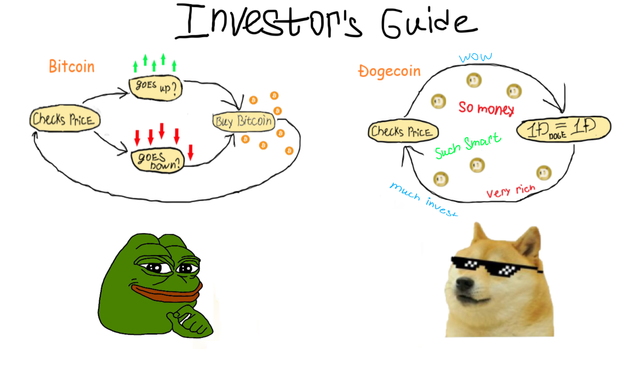
An image to attract the attention of the reader. [1]
As was at the beginning of the era of the Internet, nobody could predict what innovations new technologies would bring to the world. With blockchain, if someone could imagine that Bitcoin would, probably, become the foundation of the next decentralized financial system, the cascade of ideas that followed it hardly could be forseen by anyone. Sometimes, these new ideas integrate into our lives rather seamlessly. When we hear about such implementations we most often think something like: “oh, nice, that makes sense”. But once in a while there are absolutely beautiful, yet nonsensical and delusional ideas that come straight out of the blue and cause you a little cognitive shock.
Like, for example… Meme Markets
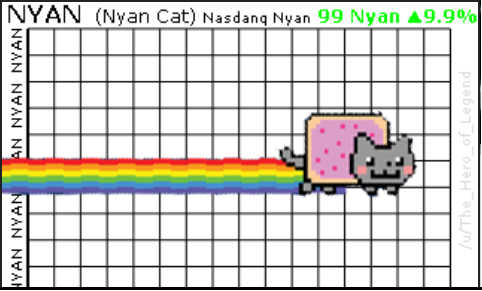
A comprehensive technical price analysis taken from [2].
Wait, what!?
Meme Markets. They are markets, where people can invest their fortunes into a well-diversified portfolio of funny (or not so) pictures with random letters in hopes that they will spread like a mental virus from person to person and, eventually, will reach CNBC or whatever main channel in your country is. Where they will become the ultimate fun of the masses and quickly degrade into obsolescence, maybe even returning back to you from the side, where you expect and dread such an attack the least of all — from your parents or grandma.
But…why?
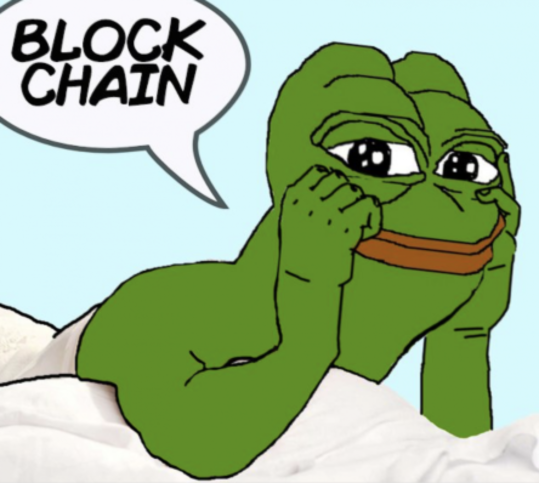
Cures cancer, walks on the water, and creates cute kitties
Alright, let’s bring in some rationality.
First, on the basis of an article from Simon de la Rouviere “History Is Rhyming: Fitness Functions & Comparing Blockchain Tokens To The Web” [3], we will state the thesis that “ Everything will be tokenized”.
According to Simon, the reality is:
“Blockchain tokens have reduced the cost to tokenize coordination by orders of magnitude, and thus we are likely to see the effective tokenization (and by extension, the introduction of markets) into almost everything.”
And, that, in fact, makes sense. Because what is the cost of tokenizing ANY sort of a thing? You just need to write few lines of code that will issue your token. Imagine the world in one or two years. You will be able to program a simple (or maybe even a fancy one) smart-contract on your mobile, issue any kind of a token and airdrop it to the millions of wallets.
The real problem will be in user aquisition (to build up the network effect) for such token. Because, if you issue your own cryptocurrency — Bobcoins and nobody else uses it, well, you have just created something like tons of other-crypto crap. However, if you are Telegram (also created TONs!) and have 200m users, you have just tried to become an alternative financial system for the world.
But..memes.. Why would anyone do something like this?
Probably you will be amazed, but the world is ripe for the meme tokenization (or shell we say memenization?). Don’t believe me? Watch this:
Dogecoin — was a joke meme-coin at the beginning and now sits at $400 million (at the time of writing) market capitalization, being the 47h largest cryptocurrency. 47th! There are 1500 other “Ethereum killers”, “better Bitcoins” and “IoT futures” and yet, Doge dominates them like a boss.

Had no ICO, still better than yours.
Here I want to emphasize that Dogecoin hasn’t had much development over the years. It also doesn’t have a marketing budget, strategic partners, masternodes, staking mechanism, governance — no one to pump its price. However, the Doge community is growing steadily and has 118.273 shibes at the moment.
The other example, of course, is Pepe Cash — not so impressive as papa Doge, but a rare Pepe currency has $17m market capitalization and serves as another example of how meme-related coins can find a place at the market.
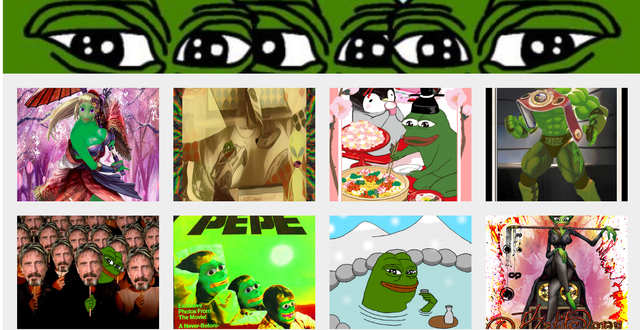
You cannot buy this for dollars…
So, now, when we know that memes can be pretty successfully valued at the market, let’s have a look at the “end users”, who might adopt all that insanity.
The first place I want to share with you has exactly the right name to be in this article. It is a subreddit named “Meme Economy”.
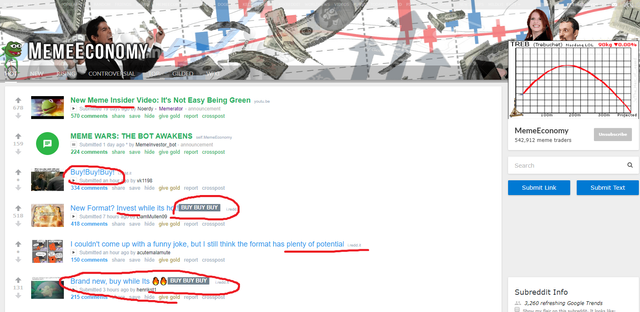
Become a memellionaire and make your mom proud of you [2].
What the hell is that?
It is a community of 543.000 people, who share memes and vote on them. As you can see, the format of posting and attracting people into voting for your meme is highly referenced to the trading of memes. We even can view it as a proto-market of a sort, where the person who “bought in” (posted a meme) early can get “a profit” in increasing his or her reputation if other users “buy” (find this meme attractive) this meme with their votes.
In addition to Meme Economy group, there are hundreds of sites and publics in various social networks all over the internet, dedicated to exactly this: sharing and voting on memes. 9gag, dank memes subreddit — are some of the other examples.
Thus, the number of people, who are engaged in the memes “consumption” or spreading is huge (let’s be realistic, it is almost anyone, who uses the internet).
Meme life cycle
What is even more staggering is that the cycle of a meme popularity resembles the typical financial bubbles very closely. As in the financial markets, where the initial price action starts with “the smart money” and then is followed by institutional and public investors, ultimately leading to “overbuying” and market crash, the spreading of a meme has alike stages.
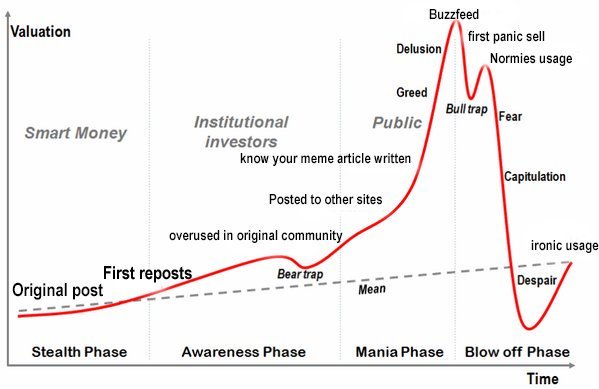
As people are herd animals, their “herding ” tends to create huge price imbalances at the financial markets with periods of mass euphoria and depression. With memes, we can track the same herding effect, which is initiated with a relatively narrow group of people, who actually can produce memes, and later expansion into the broad audience with the early community being already bored by the meme.
The last bit I want to add to the argument of the market readiness for meme tokenization is that this idea seems so ridiculous that there are a number of fun videos and memes were created around exactly the “meme investor lives” and “meme billionaires”. Imagine how fun it will be for so many people to actually do try this. Here are some examples:

Druzhko Show (in Russian) and The Wolf of Meme Street [4,5].
Now, if you are still reading, you might ask:
“But how is it even possible to trade… memes? “
I have two possible answers for this:
Bonding curves
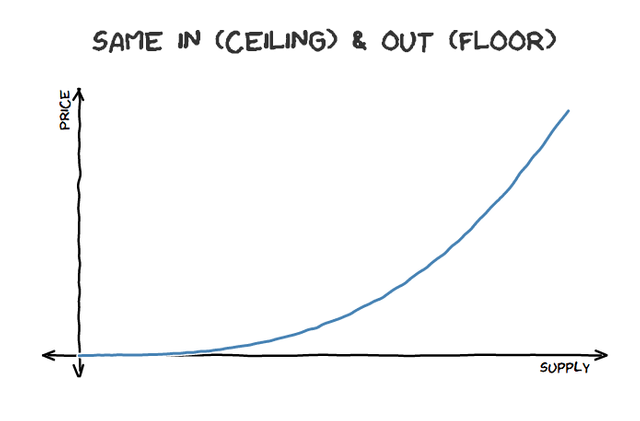
The picture and the idea taken from [6].
Bonding curves — are smart contracts that algorithmically define the relationship between a token’s price and its supply. In other words, it fixes the price for every token you buy and sell in a dependance with the token’s supply.
Let’s see an example:
- You buy a bonding curve token (BCT) with ETH through a smart contract. Your ETH stays in that particular smart contract. It is not transferred to any team or organization.
- The price of you buying is programmed into the smart contract and depends on the current token’s supply. Ex.: you buy for 0.01ETH if there are 10 BCT tokens in circulation and you buy for 0.011ETH if there are 11 BCT in circulation. The more BCT in circulation = the higher the price.
- Your sell-back price is also determined by the same bonding curve algorithm. You (and anyone else) can sell your BCT for 0.011ETH if there are 11 BCT in circulation and for 0.01ETH if there are 10 BCTs. The fewer BCT tokens in circulation = the lower the price.
Therefore, the sooner you buy the BCT, the cheaper it will be for you. If more people buy in, you will be able to sell back your BCT with a profit.
Even though at the moment it may resemble an old-good financial pyramid, I definitely see that Meme Bonding Curves may emerge and, what is important, to continue evolving with time. If someone is able to tie the popularity of a meme (which is actually can be easily measured by, say, Google trends) to a token price in a smart contract the impact will be huge.
I definitely can imagine how the millions of teenagers around the world will start losing their pocket money (or making fortunes) due to some Pepe the Frog meme bubble burst =D
Token Curated Registries (TCR)
The idea is simple: People can propose to include an item in a curated registry. To do so, one should back its proposal with a stake. After the proposal becomes visible to other people, they can support it with their own “support stakes” or challenge it making a “challenge stake” if they think that an item doesn’t belong to the list.
After a passing of a certain period of time, if the amount staked in support of a proposal is higher than the “challenge stake”, the item becomes a part of a curated registry, the “support stakes” are refunded to the supporters, and the stakes of challengers are slashed the redistributed to the supporters as a bonus. If the “challenge stake” is higher though, the supporters will have their stakes slashed and the challengers will be rewarded.
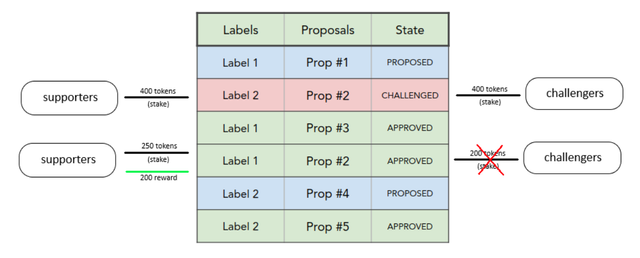
Mostly taken from “Curated Governance with Stake Machines” by Dimitri De Jonghe [1].
and here is how it should look like with memes:
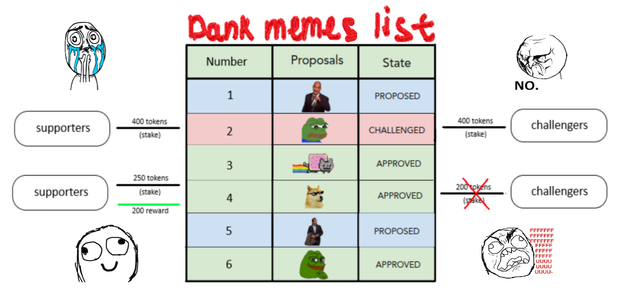
Mostly taken out of my head
With TCR it becomes quite possible to create a curated list of dank memes and to form a community, which will decide whether a meme is dank or not. Theoretically, in future, every subreddit or a public group in any of the social networks will be able to transform to a curated list of a sort. Right now the great posts in subreddits result in the additional reputation (karma) for the author of the post. After transforming into a token curated registry, the members of a subreddit will be able to stake their tokens to decide which content is viable for addition to the group and will be rewarded for that activity.
Conclusion:
Blockchain and tokenization may bring innovation in very unusual areas of human activity. One of such areas is memes. The bonding curves unlock the possibility of financial speculation on the popularity of a meme, this has a potentially huge market and may become viral due to its absurdity, unseriousness, and hilariousness. Such argument especially makes sense if we remember that the first viral dapp was cute kitties on blockchain.
With the concept of Token Curated Registries (TCR) it becomes possible to introduce betting and financially rewarding to the process of meme selection, which can potentially transform how the sites like 9gag and subreddits like Meme Economy work. Such communities consist of hundreds of thousands and even millions of users, that is why the adoption may be huge.
I believe that meme tokenization has a high probability to come true. The viral popularity of memes, huge potentially addressable market and the similarities between memes’ popularity and financial markets’ price movements — are the main rationalities behind this idea. That is why I think it may worth keeping an eye on the development of meme-related markets.
The general purpose of the article was to introduce the reader to some of the ways blockchain can transform the world. Whether memes tokenization is a success or not, it is always a good idea to keep track of the possible ways innovations can develop.
The bonding curves and TCRs are interesting topics by themselves.
Just in in case you are now like:

The Meme Factory Project
It is a district0x project that creates a TCR for dank memes. The users will be able to create a list of memes that they consider dank enough to be included in it.
If you would like to take part in the Meme Factory project, then you can visit their website and join district0x telegram to know more details. Right now they have a meme design competition (with rewards). Later, they will hold several rounds of community voting with DNT (a native token of district0x) and the participants, that staked their DNT tokens and voted will later be airdropped with the Meme Factory project tokens.
Also, you can check out the work of Simon de la Rouviere — a person, whose writings gave me the understanding of TCRs (hope that I got the concept right).
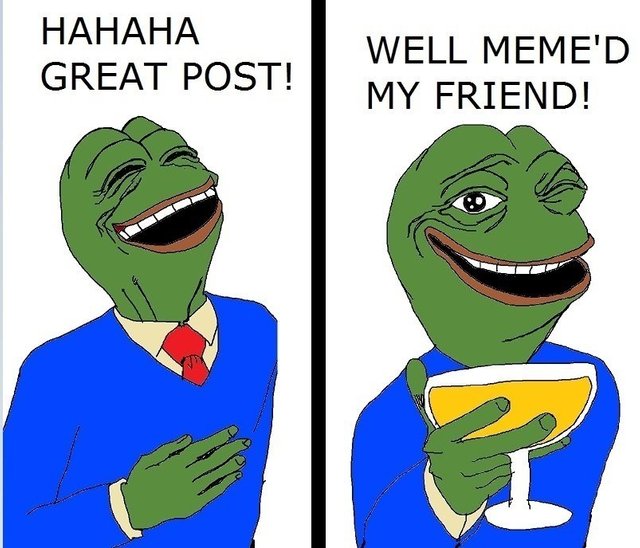
If you liked the article feel free to follow me/discuss the topic/ask me questions. I do ICO analytics and write articles:
Twitter: https://twitter.com/IvKrll
Telegram announcement channel: https://t.me/sellthehype_ANN
ICO ratings spreadsheet: https://docs.google.com/spreadsheets/d/1so2z8k9N-6zdaAp5sXNPUWQ3t43YIZwqNijOLJv5xNU/edit#gid=2055786517
In case you want to support or tip me:
Bitcoin: 1KTmAWQ5cjKVjhVCjum73mKtWQqiSny5gu
Ethereum: 0xD3474BD2f558B12e83810EC7d8aF14f2d1D08137
Doge: DEphBHAxTEr6aQUySErLxojPiCNozjgWbj
References:
The idea has been borrowed and customised from Dimitri De Jonghe, https://medium.com/@DimitriDeJonghe/curated-governance-with-stake-machines-8ae290a709b4 I don’t remember when I laughed so hard the last time.
Meme Economy reddit https://www.reddit.com/r/MemeEconomy/
Simon de la Rouviere “History Is Rhyming: Fitness Functions & Comparing Blockchain Tokens To The Web” https://medium.com/@simondlr/tokens-2-0-curved-token-bonding-in-curation-markets-1764a2e0bee5 https://hackernoon.com/history-is-rhyming-fitness-functions-comparing-blockchain-tokens-to-the-web-3c117239f4c
Druzhko show https://www.youtube.com/channel/UCpbOjOjnLBXpi0AzruoJYIA/videos
The Wolf of Meme Street
Simon de la Rouviere Tokens 2.0: Curved Token Bonding in Curation Markets https://medium.com/@simondlr/tokens-2-0-curved-token-bonding-in-curation-markets-1764a2e0bee5
The Meme Factory Project. https://memefactory.io/
Coins mentioned in post:
Downvoting a post can decrease pending rewards and make it less visible. Common reasons:
Submit